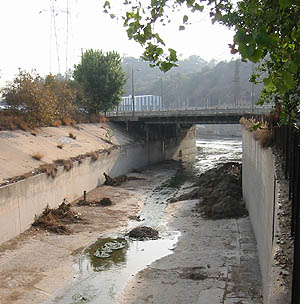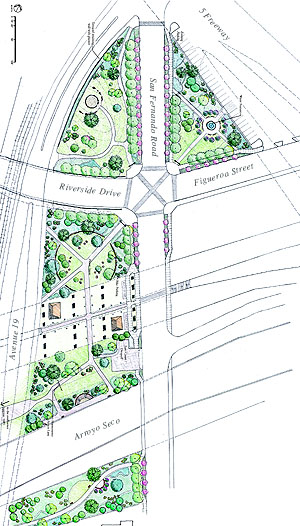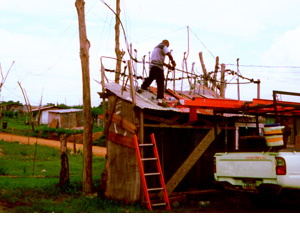issue 5
confluence park, los angeles
case study by jennifer price
the confluence today
[photo by catherine hollis]
plan for confluence
park [image
credit]
Thomas Guide page 594 J-6
Welcome
to one of the ugliest, most devastated spots on the Los Angeles River - that is,
if you can find it. The confluence of the river and the Arroyo Seco can take
some effort to locate - three separate tries, in my case - amid a hellscape of
train tracks, freeways and overpasses, fences, truck-parking lots, homeless
encampments, human feces, and trash. This spot is where L.A. was founded. It's
the center of the L.A. River watershed. And it looks like a Blade Runner set
that got torn down and then put back together wrong. Right now, this spot is a
testament to the longstanding erasure of community, nature, and history in Los
Angeles.
You have to do more than squint to imagine the future Confluence
Park here - you need special glasses, almost - but this is arguably the most
logical site for a major city park in L.A. The project has drawn only a fraction
as much publicity as the two other big future riverside central L.A. parks - the
Cornfield and Taylor Yard - but its location and history should make it a crown
jewel in the ambitious overall plans to use the restoration of L.A.'s 51-mile
river to restore some community, nature, and memory to Los Angeles.
No
matter that so many Angelenos still can't find the L.A. River at all, much less
this site. The state Santa Monica Mountains Conservancy, which will oversee the
park's creation, purchased the first half acre, a current parking lot, in March.
Compared to the Cornfield and Taylor Yard, the land acquisition here should be
much easier, since much of the land is already publicly owned by the City of
L.A., the County, and Caltrans, and adjacent private chunks are not in the hands
of L.A.'s major real estate developers - which explains in part the scarcer
publicity. Also, rather than acquiring the acreage in one dramatic swoop, the
state plans to purchase and develop it piece by piece.
Government does
not always move fast. The Conservancy plans to de-parking-lot and green up the
new half acre this year, and to develop this first piece fully in the next 3 to
5 years. As the state acquires more land (the next 10 to 15 years? 20 years?),
this aggregate of parks crisscrossed by the several major roads through the area
should include native-plant landscaping, walking paths, a bicycle station,
public art, a visitor center, and exhibits on the nature and history of L.A. -
as well as paths to the new River Center, which houses the Conservancy as well
as community and nonprofit groups and features exhibits, gardens, and
parks.
The funding and political will to restore the river will have to
keep flowing. But envision - and use the special glasses if you must - the
proposed (and in-progress) 51-mile L.A. River Greenway as the backbone for a
county-wide network of greenways and parks. Confluence Park is at the center of
it all. It's the Nexus. It's the meeting point for bikeways planned to Pasadena,
to the Valley, and to downtown and into South L.A. The Gold Line, soon to
connect Downtown and Pasadena, will stop right here. The park connects up to the
Taylor Yard and down to the Cornfield parks, which themselves connect to Elysian
and Griffith Parks and to El Pueblo - and would be an essential stop in the
envisioned historic district in the central part of the city. While it sits at
the center of a regional network, the park would also provide green and
community space locally to lower-income, green-starved, long-underserved
neighborhoods. The park should incorporate watershed management features,
including wetlands restoration and a potential partial naturalization of the
river's walls, that are essential regionally to flood control, water and air
quality, water supplies, and wildlife habitat. And it commits the founding of
L.A., and the centrality of the L.A. River to L.A. and its history, to civic
memory.
You don't exactly have to run out to see the Confluence of old,
since the state does often seem to operate on geological time. But it's worth
seeing - if you can find it. It is at once one of the most hopeless and hopeful
spots in L.A.
